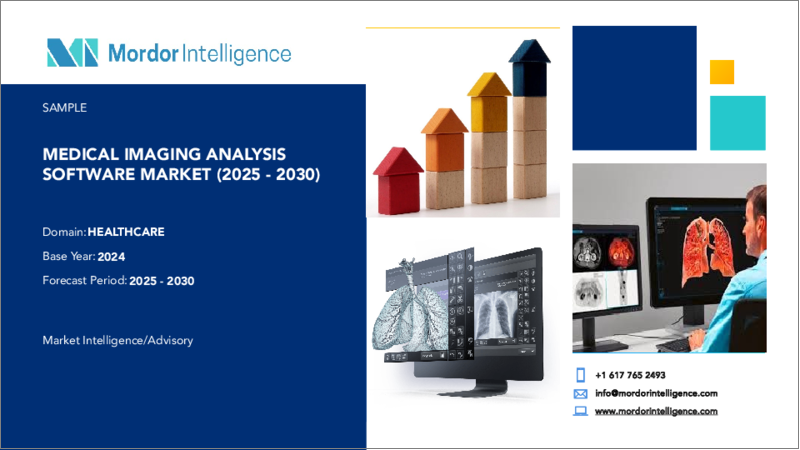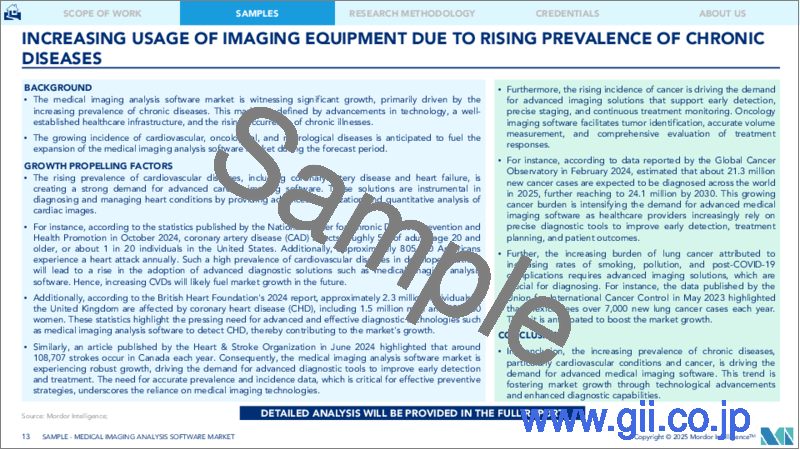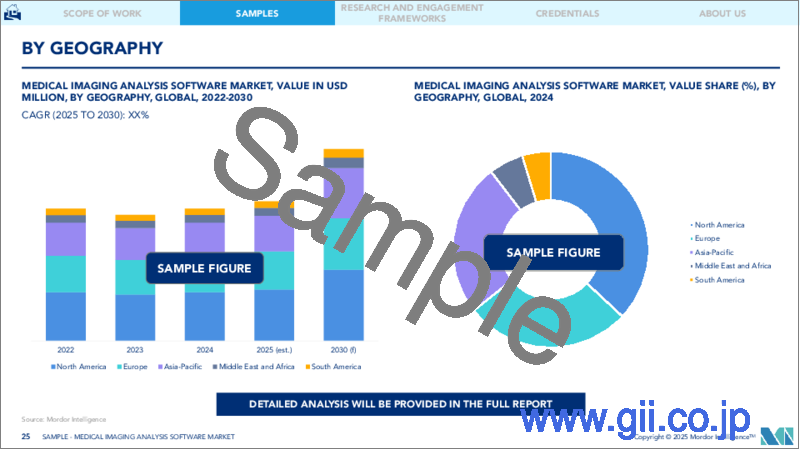|
|
市場調査レポート
商品コード
1640367
医用画像ソフトウェア:市場シェア分析、産業動向・統計、成長予測(2025年~2030年)Medical Imaging Software - Market Share Analysis, Industry Trends & Statistics, Growth Forecasts (2025 - 2030) |
||||||
カスタマイズ可能
適宜更新あり
|
|||||||
| 医用画像ソフトウェア:市場シェア分析、産業動向・統計、成長予測(2025年~2030年) |
|
出版日: 2025年01月05日
発行: Mordor Intelligence
ページ情報: 英文 100 Pages
納期: 2~3営業日
|
全表示
- 概要
- 目次
医用画像ソフトウェアの市場規模は2025年に87億5,000万米ドルと推定され、予測期間(2025~2030年)のCAGRは7.84%で、2030年には127億6,000万米ドルに達すると予測されます。

機械学習と人工知能は、これらの革新的な分析戦略がより正確で精密になったことから、ヘルスケア業界を魅了しています。
主なハイライト
- 関節炎やがんなどの高度な治療のために、医用画像ソフトウェアには高度なものが求められています。この高度な画像は、患者の状態についてより詳細な情報を提供することで、医師やその他のヘルスケア専門家に力を与えることで、患者の治療を進め、業務の生産性を向上させるために使用されます。
- 歯科、整形外科、循環器科、産婦人科、マンモグラフィ、泌尿器科、神経科などのアプリケーションにおける画像診断ソフトウェアの需要の増加が、市場成長に寄与すると予想されます。
- 特に慢性疾患の早期診断のために超音波画像診断装置の使用が増加していることが、市場の需要を牽引していると思われます。さらに、コンピュータ支援診断(CAD)などの画像技術の進歩が進んでいることも、これらのシステムの需要を押し上げると予想されます。医療用画像診断における人工知能(AI)の採用は、近年の市場動向を一変させ、今後の成長にプラスの影響を与えると予想されます。
- 画像診断機器の高額なコストは、ソフトウェアの導入費用やライセンシング費用の増加と相まって、特に償還シナリオの乏しい国々では、市場拡大の最大の制約となっています。例えば、発展途上国の病院や診断センターなどのヘルスケア施設の多くはコストがかかります。
- COVID-19の大流行時には、さまざまなAI、機械学習、ディープラーニング技術が医療画像処理に応用されたが、これは市場拡大をさらに促進すると思われます。より良い患者転帰のための効率的なソリューションへの需要が高まっているため、診断機関や研究機関が画像解析ソリューションの重要なエンドユーザーとして台頭してくると予想されます。医療アプリケーションの技術的進歩により、市場はパンデミック後に増加しています。
医用画像ソフトウェア市場動向
市場セグメンテーション:心臓病学アプリケーションが主要シェアを占める
- 心臓に関連する慢性疾患の頻度が世界的に増加しているため、医用画像ソフトウェアの需要が増加しています。こうした需要の高まりを受けて、市場開拓を進める有力企業は、研究開発や新製品の投入、合弁事業や買収に注力しています。
- 例えば、フィリップスは2022年3月、画像処理業界のさまざまなワークフロー需要に対応するために設計された、完全に統合されたクラウド対応の医療ITプラットフォーム「Health Suite Interoperability」を発表しました。
- 医用画像ソフトウェアは、解析速度と精度を向上させることがわかっています。世界中の主要企業は、AIやクラウドコンピューティングのような新技術を統合し、新しい医用画像ソフトウェアアプリケーションを導入しています。例えば、サンフランシスコにあるArterysは、ディープラーニングAIアルゴリズムとクラウドコンピューティングを組み合わせています。Arterysは心臓MRI用に設計されており、これらの領域の異常病変の特定を支援します。
- 2022年2月、クリーリーは、動脈硬化の量と種類に基づいて心臓病を追跡するソフトウェアの新バージョン、クリーリー2.2.0を発売しました。このような市場のイノベーションと新製品のリリースは、医療画像ソフトウェア市場規模の拡大に貢献しています。
- 心臓移植のような心臓の問題では、医用画像ソフトウェアは容積や機能的なデータ分析を知るために使用されます。Scandiatransplantによると、2021年の北欧諸国の心臓移植患者数はスウェーデンが最も多く、66人が新しい心臓を移植されました。デンマークは2番目に移植患者数が多く、24人でした。
北米が最大の市場規模を記録する見込み
- 北米は、世界最大の医用画像ソフトウェア市場になると予想されています。同地域は、特に米国、メキシコ、カナダといった国々において、医療インフラへの投資がかなり高い水準にあります。このシナリオは、同地域におけるハードウェアの増加と相まって、医用画像ソフトウェアの需要を押し上げると予想されます。
- 同地域では、最新の診断機器を備えた医療機関が整備されていることや、医療ITの利用を促進する政府の施策が好都合であることが、需要拡大の要因となっています。さらに、研究開発投資の増加や競合他社の存在が、この地域の市場拡大に拍車をかけています。
- 2022年10月、大手ヘルスケアIT企業の1つであるEnlitic社は、本格的な部品、機器、サービスを提供するヘルスケア技術プロバイダーであるMULTI Inc.との新たな提携を発表しました。両社は、米国中のヘルスケアプロバイダーにEnlitic Curieプラットフォームを提供し、放射線科の業務効率化を支援するために協力しました。質の高い患者ケアの必要性が高まる中、病院の指導者は、より効率的な業務を構築すると同時に、より良い患者転帰に貢献する収益の見通しを拡大することに重点を置いています。このような目的を達成するために、Curie|ENDEXアプリケーションは放射線部門内の複数のユーザーのワークフローに影響を与えます。
- その結果、多くの医用画像ソフトウェアベンダーは、複数のネットワークから画像にアクセスでき、サードパーティ製または集中型の電子カルテ(HER)システムと統合できるベンダーニュートラルアーカイブ(NVA)技術に移行しています。
- 米国がん学会の推計によると、2022年1月に米国で新たに登録される肺がんと気管支がんの症例数は2,36,740例です。これらの症例数が最も多いのはフロリダ州と推定されています。がん患者の増加により、医用画像ソフトウェアの使用が必要となっています。
医用画像ソフトウェア業界の概要
この市場の競争企業間の敵対関係は、General Healthcare Company(GE)、Koninklijke Philips N.V.、Siemens Healthcare、Canon Medical Systems Corporation、Agfa Gevaert HealthCareなどの有力企業が存在するため高いです。業界各社は、M&A、パートナーシップ、絶え間ないイノベーションにより競争優位性を獲得するため、常に製品ポートフォリオを開発しています。
- 2022年6月-CT、MRI、超音波、アイケア、診断用X線装置、インターベンショナルX線装置、モバイル・イメージング・ソリューション、ヘルスケアITソリューション一式など、医療画像ソリューション全般を提供するキヤノンメディカルシステムズ株式会社は、2022年にウィーンで開催される欧州放射線学会(European Society of Radiology)とのパートナーシップを拡大しました。このパートナーシップにより、キヤノンメディカルはESRの患者様に医療画像ソリューションを提供します。
その他の特典
- エクセル形式の市場予測(ME)シート
- 3ヶ月間のアナリストサポート
目次
第1章 イントロダクション
- 調査の前提条件と市場定義
- 調査範囲
第2章 調査手法
第3章 エグゼクティブサマリー
第4章 市場洞察
- 市場概要
- 産業バリューチェーン分析
- 業界の魅力度-ポーターのファイブフォース分析
- 新規参入業者の脅威
- 買い手の交渉力
- 供給企業の交渉力
- 代替品の脅威
- 競争企業間の敵対関係の強さ
- COVID-19の市場への影響評価
第5章 市場力学
- 市場促進要因
- コンピュータ支援診断法の応用拡大
- 市場抑制要因
- 熟練した専門家の不足と機器のセットアップコストの高さ
第6章 市場セグメンテーション
- 画像タイプ別
- 2Dイメージング
- 3Dイメージング
- 4Dイメージング
- 用途別
- 歯科用途
- 整形外科
- 心臓病学用途
- 産婦人科用途
- マンモグラフィー
- 泌尿器・腎臓用途
- その他の用途
- 地域別
- 北米
- 米国
- カナダ
- 欧州
- ドイツ
- フランス
- 英国
- その他欧州
- アジア太平洋
- 中国
- 日本
- インド
- その他アジア太平洋地域
- 世界のその他の地域
- ラテンアメリカ
- 中東・アフリカ
- 北米
第7章 競合情勢
- 企業プロファイル
- General Healthcare Company(GE)
- Koninklijke Philips N.V.
- Siemens Healthcare
- Canon Medical Systems Corporation
- Agfa Gevaert HealthCare
- Novarad Corporation
- Carestream Health Inc.
- Esaote SpA.
- MIM Software Inc.
- Fujifilm Holding Company
- Cerner Corporation
- Change Healthcare
第8章 投資分析
第9章 市場機会と今後の動向
The Medical Imaging Software Market size is estimated at USD 8.75 billion in 2025, and is expected to reach USD 12.76 billion by 2030, at a CAGR of 7.84% during the forecast period (2025-2030).

Machine learning and artificial intelligence have attracted the healthcare industry as these innovative analytics strategies have become more accurate and precise.
Key Highlights
- The need for medical imaging software for advanced treatment for people with arthritis, cancer, etc., demands an advanced version. This advanced image is used to advance patient care and improve operating productivity by empowering doctors and other healthcare professionals by providing more details about patient conditions.
- An increase in demand for diagnostic imaging software in applications such as dental, Orthopedic, Cardiology, obstetrics and gynecology, Mammography, urology, and neurology, is expected to contribute to the market growth.
- The increasing use of ultrasonic imaging equipment for earlier diagnosis, particularly chronic disorders, is likely to drive the market's demand. Furthermore, ongoing advancements in imaging technologies, such as Computer-aided Diagnosis (CAD), are expected to boost demand for these systems. The adoption of Artificial Intelligence (AI) in medical imaging has transformed market trends in recent years and is expected to impact future growth positively.
- The high cost of imaging equipment, combined with the increased implementation and licensing fees of software, is the biggest constraint to market expansion, particularly in countries with poor reimbursement scenarios. For example, most healthcare facilities in developing nations, such as hospitals and diagnostic centers, have costs.
- During the COVID-19 pandemic, various AI, machine learning, and deep learning technologies were applied in medical image processing, which will drive market expansion further. Because of the increasing demand for efficient solutions for better patient outcomes, diagnostic and research institutes are expected to emerge as significant end users of image analysis solutions. Due to the technological advancements in medical applications, the market is increasing after the pandemic.
Medical Imaging Software Market Trends
Cardiology Applications Segment Holds Major Market Share
- As the frequency of chronic diseases related to the heart is increasing globally, the demand for medical imaging software is increasing. With such rising demand, prominent market players are focusing on R&D and new product launches, as well as joint ventures and acquisitions, to develop their businesses.
- For instance, in March 2022, Philips announced Health Suite Interoperability, a fully integrated cloud-enabled Health IT platform designed to address the different workflow demands of the imaging industry.
- Medical image software has been found to improve analysis speed and accuracy. Key players around the globe are integrating emerging technologies like AI and Cloud computing to introduce new medical imaging software applications. For instance, Arterys, located in San Francisco, combines deep learning AI algorithms with cloud computing. Arterys designed for cardiac MRIs to assist in identifying abnormal lesions in these areas.
- In February 2022, Cleery launched Cleerly 2.2.0, a new software version that tracks heart disease based on the quantity and kind of atherosclerosis. Such market innovations and new product releases contribute to expanding the Medical Imaging Software Market Size.
- In Cardiac problems like heart transplantation, medical imaging software is used to know the volumetric and functional data analysis. According to Scandiatransplant, the number of heart transplant recipients in the Nordic countries in 2021 Sweden had the most significant number of transplanted heart patients, with 66 individuals transplanted a new heart. Denmark had the second-highest number of transplants, with 24 patients.
North America is Expected to Register the Largest Market
- North America is expected to be the largest market for medical imaging software globally. The region has a considerably high level of investments in medical infrastructure, especially in countries like the United States, Mexico, and Canada. This scenario, coupled with the increasing multitude of hardware in the region, is expected to boost the demand for medical imaging software.
- The expansion can be attributed to the availability of well-established healthcare institutions equipped with modern diagnostic equipment and favorable government measures to boost the use of healthcare IT in this region. Furthermore, rising R&D investments and the presence of significant market competitors are fueling regional market expansion.
- In October 2022, Enlitic, one of the leading healthcare IT firms, announced a new partnership with MULTI Inc., a healthcare technology provider of authentic parts, equipment, and services. The two organizations collaborated to provide the Enlitic Curie platform to healthcare providers across the United States to assist radiology departments in driving operational efficiencies. As the need for high-quality patient care grows, hospital leaders focus on building more efficient operations while expanding revenue prospects that contribute to better patient outcomes. To achieve these aims, the Curie|ENDEX application impacts the workflows of several users within the radiology department.
- As a result, many medical imaging software vendors are moving towards vendor-neutral archive (VNA) technologies that enable access to images form several networks and the ability to integrate them with third-party or centralized Electronic Health Record (HER) systems.
- According to the American Cancer Society estimation in January 2022, the number of new lung and bronchus cancer cases registered in the United States is 2,36,740. The highest number of these cases is estimated to be in Florida. The increase in cancer patients necessitates the use of medical imaging software.
Medical Imaging Software Industry Overview
The competitive rivalry in this market is high because of dominant players like General Healthcare Company (GE), Koninklijke Philips N.V., Siemens Healthcare, Canon Medical Systems Corporation, and Agfa Gevaert HealthCare, among others. The industry players constantly develop their product portfolios to gain competitive advantages with mergers and acquisitions, partnerships, and constant innovations.
- June 2022 - Canon Medical Systems Corporation, which provides a full range of medical imaging solutions such as CT, MRI, Ultrasound, Eye Care, Diagnostic and Interventional X-Ray equipment, Mobile Imaging Solutions, and a full suite of Healthcare IT solutions, has expanded its partnership with the European Society of Radiology for the 2022 onsite edition in Vienna. Through the partnership, Canon Medical offers its medical imaging solutions to ESR patients.
Additional Benefits:
- The market estimate (ME) sheet in Excel format
- 3 months of analyst support
TABLE OF CONTENTS
1 INTRODUCTION
- 1.1 Study Assumptions and Market Definition
- 1.2 Scope of the Study
2 RESEARCH METHODOLOGY
3 EXECUTIVE SUMMARY
4 MARKET INSIGHTS
- 4.1 Market Overview
- 4.2 Industry Value Chain Analysis
- 4.3 Industry Attractiveness - Porter's Five Forces Analysis
- 4.3.1 Threat of New Entrants
- 4.3.2 Bargaining Power of Buyers
- 4.3.3 Bargaining Power of Suppliers
- 4.3.4 Threat of Substitute Products
- 4.3.5 Intensity of Competitive Rivalry
- 4.4 Assessment of Impact of COVID-19 on the Market
5 MARKET DYNAMICS
- 5.1 Market Drivers
- 5.1.1 Growing Application of Computer-Aided Diagnostic Methods
- 5.2 Market Restraints
- 5.2.1 Dearth of Skilled Professionals and High Set-up Cost of the Equipment
6 MARKET SEGMENTATION
- 6.1 By Imaging Type
- 6.1.1 2D Imaging
- 6.1.2 3D Imaging
- 6.1.3 4D Imaging
- 6.2 By Application
- 6.2.1 Dental Applications
- 6.2.2 Orthopaedic Applications
- 6.2.3 Cardiology Applications
- 6.2.4 Obstetrics and Gynaecology Applications
- 6.2.5 Mammography Applications
- 6.2.6 Urology and Nephrology Applications
- 6.2.7 Other Applications
- 6.3 Geography
- 6.3.1 North America
- 6.3.1.1 United States
- 6.3.1.2 Canada
- 6.3.2 Europe
- 6.3.2.1 Germany
- 6.3.2.2 France
- 6.3.2.3 United Kingdom
- 6.3.2.4 Rest of Europe
- 6.3.3 Asia-Pacific
- 6.3.3.1 China
- 6.3.3.2 Japan
- 6.3.3.3 India
- 6.3.3.4 Rest of Asia-Pacific
- 6.3.4 Rest of the World
- 6.3.4.1 Latin America
- 6.3.4.2 Middle-East & Africa
- 6.3.1 North America
7 COMPETITIVE LANDSCAPE
- 7.1 Company Profiles
- 7.1.1 General Healthcare Company (GE)
- 7.1.2 Koninklijke Philips N.V.
- 7.1.3 Siemens Healthcare
- 7.1.4 Canon Medical Systems Corporation
- 7.1.5 Agfa Gevaert HealthCare
- 7.1.6 Novarad Corporation
- 7.1.7 Carestream Health Inc.
- 7.1.8 Esaote SpA.
- 7.1.9 MIM Software Inc.
- 7.1.10 Fujifilm Holding Company
- 7.1.11 Cerner Corporation
- 7.1.12 Change Healthcare





